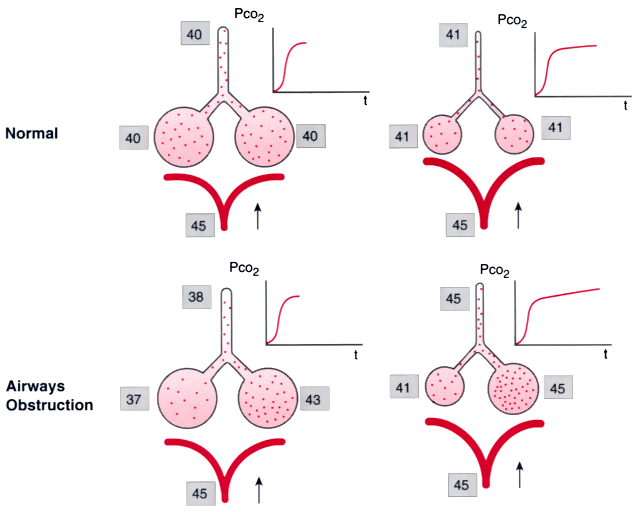 |
 |
Figure 36-19
Mechanisms of airways obstruction producing an upsloping
phase III capnogram. In a normal, healthy person (upper panel), there is a narrow
range of V̇A/ ratios with values close
to 1. Gas exchange units therefore have similar PCO2
and tend to empty synchronously, and the expired PCO2
remains relatively constant. During the course of exhalation, the alveolar PCO2
slowly rises as CO2
continuously diffuses from the blood. This causes
a slight increase in PCO2
toward the end
of expiration, and this increase can be pronounced if the exhalation is prolonged
(see Fig. 36-18C
). In a
patient with diffuse airways obstruction (lower panel), the airway pathology is heterogeneous,
with gas exchange units having a wide range of V̇A/
ratios with values close
to 1. Gas exchange units therefore have similar PCO2
and tend to empty synchronously, and the expired PCO2
remains relatively constant. During the course of exhalation, the alveolar PCO2
slowly rises as CO2
continuously diffuses from the blood. This causes
a slight increase in PCO2
toward the end
of expiration, and this increase can be pronounced if the exhalation is prolonged
(see Fig. 36-18C
). In a
patient with diffuse airways obstruction (lower panel), the airway pathology is heterogeneous,
with gas exchange units having a wide range of V̇A/ ratios. Well-ventilated gas exchange units, with gas containing a lower PCO2
,
empty first; poorly ventilated units, with a higher PCO2
,
empty last. In addition to the continuous rise in PCO2
mentioned previously, there is a progressive increase caused by asynchronous exhalation.
ratios. Well-ventilated gas exchange units, with gas containing a lower PCO2
,
empty first; poorly ventilated units, with a higher PCO2
,
empty last. In addition to the continuous rise in PCO2
mentioned previously, there is a progressive increase caused by asynchronous exhalation.

 |
![]() ratios with values close
to 1. Gas exchange units therefore have similar PCO2
and tend to empty synchronously, and the expired PCO2
remains relatively constant. During the course of exhalation, the alveolar PCO2
slowly rises as CO2
continuously diffuses from the blood. This causes
a slight increase in PCO2
toward the end
of expiration, and this increase can be pronounced if the exhalation is prolonged
(see Fig. 36-18C
). In a
patient with diffuse airways obstruction (lower panel), the airway pathology is heterogeneous,
with gas exchange units having a wide range of V̇A/
ratios with values close
to 1. Gas exchange units therefore have similar PCO2
and tend to empty synchronously, and the expired PCO2
remains relatively constant. During the course of exhalation, the alveolar PCO2
slowly rises as CO2
continuously diffuses from the blood. This causes
a slight increase in PCO2
toward the end
of expiration, and this increase can be pronounced if the exhalation is prolonged
(see Fig. 36-18C
). In a
patient with diffuse airways obstruction (lower panel), the airway pathology is heterogeneous,
with gas exchange units having a wide range of V̇A/![]() ratios. Well-ventilated gas exchange units, with gas containing a lower PCO2
,
empty first; poorly ventilated units, with a higher PCO2
,
empty last. In addition to the continuous rise in PCO2
mentioned previously, there is a progressive increase caused by asynchronous exhalation.
ratios. Well-ventilated gas exchange units, with gas containing a lower PCO2
,
empty first; poorly ventilated units, with a higher PCO2
,
empty last. In addition to the continuous rise in PCO2
mentioned previously, there is a progressive increase caused by asynchronous exhalation.